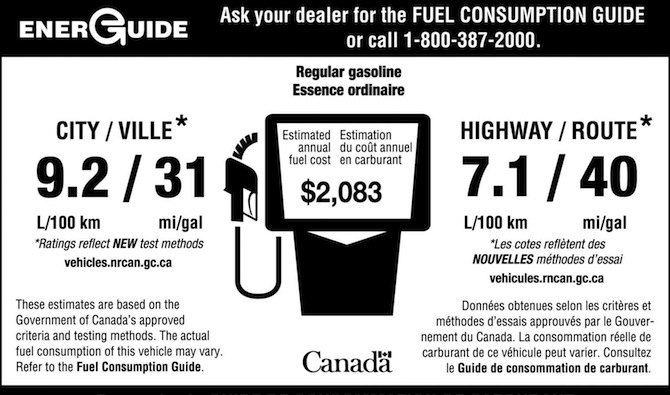“The Government of Canada has finally approved the five-cycle test method, already used in the U.S. since 2008…”
A new fuel consumption rating system kicks in for all 2015 model year new cars and light trucks. The Government of Canada has finally approved the five-cycle test method, already used in the US since 2008. In general, those predicted fuel consumption figures on the EnerGuide label (on every new vehicle) will increase somewhere in the 10 to 20 per cent range, compared to a similar, or even identical, 2014 model year vehicle.
As before, vehicle manufacturers are required to submit fuel consumption data to the federal government based on controlled laboratory testing procedures. This is done in order to produce results that are consistent and repeatable and includes the use of standardized fuels, test cycles and calculations. The underlying objective is to give a Canadian consumer making a new vehicle purchase decision an accurate and reliable way to compare fuel consumption.
The three additional test cycles, added to the old two-cycle testing method, include cold temperature operation, air conditioner usage, and driving at higher speeds with more rapid acceleration and braking. Cars, roads and motoring habits have changed over the years and the new five-cycle test was designed to better simulate modern driving.
That said, and also as before, an owner’s actual on-road fuel consumption is still likely to be different, although closer to the new government test numbers. Real life fuel consumption not only varies depending on how and where you drive, it can also change with traffic, the weather, after dark and a bunch of other less obvious factors.
If you want to check how your current vehicle would fare (and compare) in the five-cycle test, Natural Resources Canada (nrcan.gc.ca) has an online calculation tool that gives approximate fuel economy numbers for vehicles going all the way back to 1995. This is the web link: http://oee.nrcan.gc.ca/fcr-rcf/public/index-e.cfm
The more fuel a vehicle burns is directly related to the amount of carbon dioxide, a greenhouse gas, it pumps out the tailpipe. So, not only does a more fuel efficient vehicle cost less to operate, it also has reduced environmental impact. Fuel economy now transcends the small car market and is an important concern for buyers in just about every vehicle market segment.
It’s also why fuel economy has become an increasingly important in the marketing of new vehicles, especially in the high-volume market segments. The car business is a highly competitive one and, as you might expect, auto makers try to build vehicles that do well, and get low numbers, in the government fuel economy test. A few have even overstepped the credibility line (by mistake, of course) and have agreed to compensate vehicle owners, most notably Hyundai and Kia a couple of years ago, Ford and Lincoln more recently.
Major technological changes are also happening in the fuel economy race. Smaller and more efficient gasoline engines are available, hybrid vehicle sales are taking off, plug-in hybrid vehicles are becoming more common and the pure electric vehicle is a competitive production reality. So, even the term “fuel consumption” may become obsolete, sometime in the future.
Right now, however, if you walk into a new car dealership showroom, you’ll probably find both 2014 and 2015 editions of the same model vehicle for sale, side-by-side. If you don’t notice the asterisked note under the EnerGuide fuel consumption figure on the 2015, it’s easy to assume that it’s a less fuel efficient vehicle and that’s almost certainly not correct.
The 2015 EnerGuide fuel consumption figure is simply more realistic and closer to what you’re likely to experience during day-to-day driving in the real world.
Recent Comments
- { Enjoyed your Forest of Bowland in the BMW X5M, particularly the photo of the BMW in front of the main part of Stonyhurst College where... }
- { Bantam designed the Jeep, not Willy's or Ford. The American military gave the original Bantam prototype to Willys and Ford to copy. There is plenty... }
- { All Escalades come with a 6.2-lilter V8 engine that produces 420 horsepower. A six-speed automatic is the only transmission offered and drives the rear wheels.... }
- { Alexandra is an excellent journalist. }
Popular Posts
- Journey to a ‘Sparkling’ Luxury Okanagan Resort “Four lucky readers will put a Dodge Journey’s weekend-...
- The Need For Speed: Hike Those Highway Limits More than half of those polled believe the province sho...
- Drives-U-Crazy… Erratic drivers. An early morning drive from Kelowna to Vancouver is nor...
- Readers Respond: The Pros and Cons of Increasing B.C. Speed Limits Increasing the speed limits will only increase risk to...
- Honda CR-V Review: The Compact Crossover To Get Things Done The CRV is a very stylish and aerodynamic crossover veh...







